|
Further Expansion During the First World War there were
shortages of brewing materials and a vast increase in beer
duty, which led to many alterations and innovations. For the
first time in the brewery’s history, women were employed in
many of the departments to replace the men who had gone to
war.
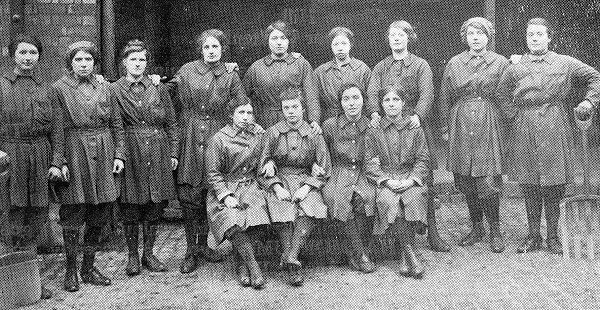
Women workers in the maltings in 1918.

Some of the fermenting room staff
during the war. After the war a bonus scheme was
introduced as an incentive for the employees, and tours of
the brewery were often organised for customers, and all kinds
of societies and groups. In 1919 new coppers and boilers
were installed, and some of the plant and machines were
renovated. |
 |
The ferro-concrete boiler house.
As seen in 2003. |
| In 1920 the appearance of the brewery, as seen from the
main yard changed dramatically with the building of the ferro-concrete boiler house,
and its
distinctive clock, added in 1921. In the same year the
brewery lost another valuable member of staff when its
Chairman, Mr. W. F. Wilson died. He was succeeded by his
son, Mr. W. R. Wilson, under whose chairmanship the brewery
went from strength to strength.
The first edition of the brewery’s
staff magazine, the Springfield Brewery Journal appeared in
December 1921. 150 copies, each with six pages were printed.
It proved very popular, so much so that nine months later
300 copies, each with fourteen pages were printed.
It temporarily came to an end in
September 1922 when the printing machine broke down, but
reappeared in April 1924. By 1927 the circulation reached
six hundred.
Around this time open fridges were
installed to allow the production of wort to be increased.
|

Mr. W. F. Wilson. Courtesy of James
Hewitt. |
|

From the April 1924 edition of the
Springfield Brewery Journal. |
Over the next few years many alterations were made
including the building of a long needed club house to cater
for the social and sporting needs of the employees.
The fully equipped club house, which
was opened
by the Chairman Mr. W. R. Wilson in November 1922, became
the headquarters of the Brewery Sports and Social Club.
In 1924 a sports ground opened. It doubled in size in 1928
after the purchase of some adjacent land.
There were facilities for bowls,
cricket, football, quoits, and tennis.
Indoor activities
included snooker and dominoes, entertainment, dances, and
amateur dramatics. |
 |
Butler's club house. |
|
The bowls teams played for the Wilson
Bowling Cup, and in the Butler’s League, and the Works
League.
In 1924 the brewery’s team played Star, Jenks and Cattell, the Chillington Tool Company, the Weldless Tube,
Harpers, and Perks.
The football, cricket, and tennis teams
played in Butler’s leagues, and works leagues.
There were
also Butlers domino, and snooker leagues. Dances included an
annual fancy dress dance, and an annual whist drive and
dance.
There was also an amateur dramatics group that
performed in the sports and social club, and elsewhere.
In
1925 ping pong and bagatelle tables were added to the club
house, and a hockey team was formed.
|
 |
|
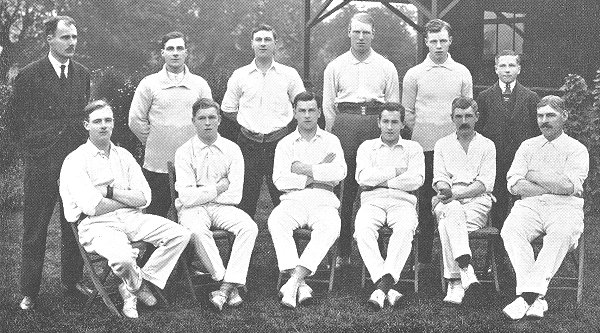
The Works Cricket Team in 1924.
Back row: P. Collins, J. Bourne, W. Clarke, F. B. Jackson, J.
Williams, and W. Bourne.
Front row: J. Hadlington, E. Brooks, G. Carvey, G. Francis, W.
Thompson, and F. Brettle.
|
|
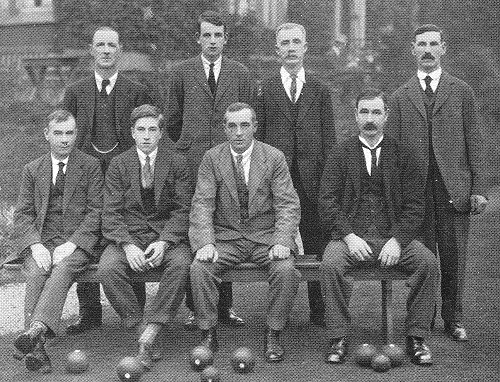
The Building Department Bowls Team in 1924. |
Back row:
H. G. Lee, G. Sambrook,
W. J. Evans, and A. Edwards.
Front row:
F. C. Ryall, A. Charles,
A. Williams (Captain), and
E.
Hales. |
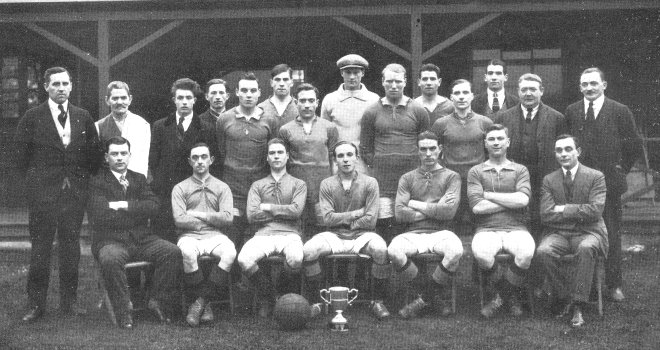
Butler's 1926 football team.
| On 9th March, 1923 Captain Theodore Addenbrooke
(described as Major Addenbrooke in the company's magazine)
unveiled the company’s war memorial in the brewery yard.
It was dedicated to those who perished in the First World
War. The names of the employees who were killed in the
Second World War were added later.
In 1996 after the closure of the site, the war memorial was moved to
the Fallings Park Territorial Army Centre following concerns
about its safety.
It has since been moved to the Black
Country Living Museum where it can be seen today. It
consists of a bronze figure of a British Soldier. |
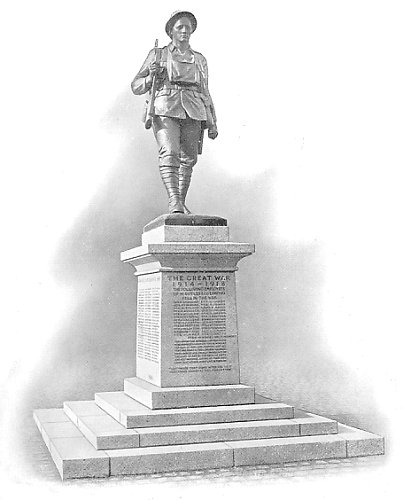
The War Memorial. |
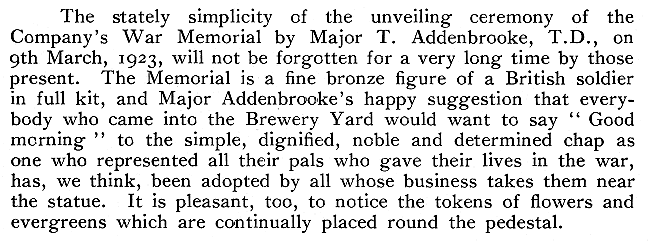
From the April 1924 edition of the Springfield
Brewery Journal.

The new Cambridge Street entrance that had been built by 1889.
|
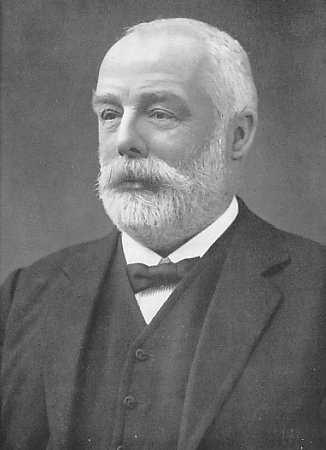
Mr. F. T. Langley, Company
Vice-Chairman. |
In 1923 Mr. C. P. Plant died. In 1924
he was replaced on the Board by Major T. Addenbrooke who had
been Secretary of the company since 1895. At the same time
Mr. A. C. Finniss became Company Secretary.
In 1924, Board member Mr. F. T.
Langley died. He was replaced by Mr. A. W. Yardley who had
been a partner in the Bloxwich Brewery. Before establishing
the Bloxwich Brewery he had worked for his father in
Darlaston who ran J.
Yardley & Son, Maltsters.
In the same year,
the Chairman Mr. W. R. Wilson, a keen gardener, won the
third prize in the Wolverhampton Flower Show for his garden
flowers. He also entered other garden competitions including the Tettenhall flower show. |
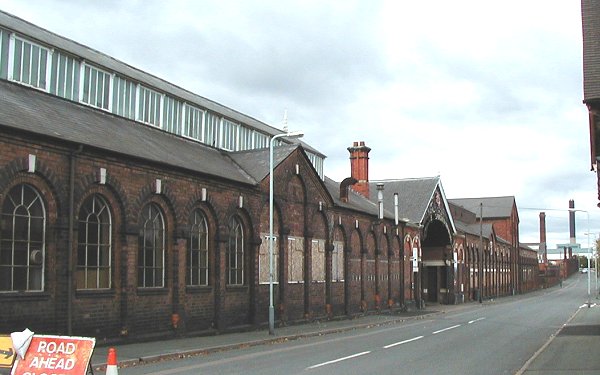
Looking along Cambridge Street in 2003.

Butler's Chairman, Mr. W. R. Wilson.

A company letterhead from 1928. Courtesy of
James Hewitt.
 |
|
 |
|
Courtesy of Frank
Sharman. |
 |
|
 |
|
 |
Return to
New Acquisitions |
|
Return to
the beginning |
|
Proceed to
More Changes |
|